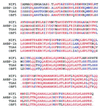Interaction of NPR1 with basic leucine zipper protein transcription factors that bind sequences required for salicylic acid induction of the PR-1 gene
- PMID: 10339621
- PMCID: PMC26915
- DOI: 10.1073/pnas.96.11.6523
Interaction of NPR1 with basic leucine zipper protein transcription factors that bind sequences required for salicylic acid induction of the PR-1 gene
Abstract
The Arabidopsis thaliana NPR1 has been shown to be a key regulator of gene expression during the onset of a plant disease-resistance response known as systemic acquired resistance. The npr1 mutant plants fail to respond to systemic acquired resistance-inducing signals such as salicylic acid (SA), or express SA-induced pathogenesis-related (PR) genes. Using NPR1 as bait in a yeast two-hybrid screen, we identified a subclass of transcription factors in the basic leucine zipper protein family (AHBP-1b and TGA6) and showed that they interact specifically in yeast and in vitro with NPR1. Point mutations that abolish the NPR1 function in A. thaliana also impair the interactions between NPR1 and the transcription factors in the yeast two-hybrid assay. Furthermore, a gel mobility shift assay showed that the purified transcription factor protein, AHBP-1b, binds specifically to an SA-responsive promoter element of the A. thaliana PR-1 gene. These data suggest that NPR1 may regulate PR-1 gene expression by interacting with a subclass of basic leucine zipper protein transcription factors.
Figures





Similar articles
-
Over-expression of TGA5, which encodes a bZIP transcription factor that interacts with NIM1/NPR1, confers SAR-independent resistance in Arabidopsis thaliana to Peronospora parasitica.Plant J. 2002 Oct;32(2):151-63. doi: 10.1046/j.1365-313x.2001.01411.x. Plant J. 2002. PMID: 12383081
-
NPR1 differentially interacts with members of the TGA/OBF family of transcription factors that bind an element of the PR-1 gene required for induction by salicylic acid.Mol Plant Microbe Interact. 2000 Feb;13(2):191-202. doi: 10.1094/MPMI.2000.13.2.191. Mol Plant Microbe Interact. 2000. PMID: 10659709
-
The Arabidopsis NPR1 disease resistance protein is a novel cofactor that confers redox regulation of DNA binding activity to the basic domain/leucine zipper transcription factor TGA1.Plant Cell. 2003 Sep;15(9):2181-91. doi: 10.1105/tpc.012849. Plant Cell. 2003. PMID: 12953119 Free PMC article.
-
NPR1: the spider in the web of induced resistance signaling pathways.Curr Opin Plant Biol. 2004 Aug;7(4):456-64. doi: 10.1016/j.pbi.2004.05.006. Curr Opin Plant Biol. 2004. PMID: 15231270 Review.
-
[Nonexpressor of pathogenesis-related genes 1 (NPR1): a key node of plant disease resistance signalling network].Sheng Wu Gong Cheng Xue Bao. 2005 Jul;21(4):511-5. Sheng Wu Gong Cheng Xue Bao. 2005. PMID: 16176083 Review. Chinese.
Cited by
-
A Genetic Screen Identifies a Requirement for Cysteine-Rich-Receptor-Like Kinases in Rice NH1 (OsNPR1)-Mediated Immunity.PLoS Genet. 2016 May 13;12(5):e1006049. doi: 10.1371/journal.pgen.1006049. eCollection 2016 May. PLoS Genet. 2016. PMID: 27176732 Free PMC article.
-
Transcriptional profiling reveals novel interactions between wounding, pathogen, abiotic stress, and hormonal responses in Arabidopsis.Plant Physiol. 2002 Jun;129(2):661-77. doi: 10.1104/pp.002857. Plant Physiol. 2002. PMID: 12068110 Free PMC article.
-
A mini-TGA protein modulates gene expression through heterogeneous association with transcription factors.Plant Physiol. 2023 Mar 17;191(3):1934-1952. doi: 10.1093/plphys/kiac579. Plant Physiol. 2023. PMID: 36517238 Free PMC article.
-
Transcription factors involved in basal immunity in mammals and plants interact with the same MAMP-responsive cis-sequence from Arabidopsis thaliana.Plant Mol Biol. 2018 Dec;98(6):565-578. doi: 10.1007/s11103-018-0796-8. Epub 2018 Nov 22. Plant Mol Biol. 2018. PMID: 30467788
-
Characterization of expressed sequence tags (ESTs) of pigeonpea (Cajanus cajan L.) and functional validation of selected genes for abiotic stress tolerance in Arabidopsis thaliana.Mol Genet Genomics. 2010 Mar;283(3):273-87. doi: 10.1007/s00438-010-0516-9. Epub 2010 Feb 4. Mol Genet Genomics. 2010. PMID: 20131066
References
Publication types
MeSH terms
Substances
Associated data
- Actions
LinkOut - more resources
Full Text Sources
Other Literature Sources
Molecular Biology Databases
Research Materials
Miscellaneous

